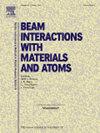L-shell X-ray production cross sections in some lanthanoids induced by He+ ions
IF 1.4
3区 物理与天体物理
Q3 INSTRUMENTS & INSTRUMENTATION
Nuclear Instruments & Methods in Physics Research Section B-beam Interactions With Materials and Atoms
Pub Date : 2025-04-05
DOI:10.1016/j.nimb.2025.165693
引用次数: 0
Abstract
For some relevant applications, the inner-shell process involving interactions between ions and atoms has been widely investigated. In this study, L-shell X-ray production cross sections of industrially important lanthanoids, induced by helium of energies to , have been calculated. At first, the ionization cross sections for the targets were obtained using the ISICS code and ERCS08 computer program based on ECPSSR-UA and PWBA+OBKN theories, respectively. The calculated ionization cross sections were then converted to X-ray production cross sections. Also, the role of multi-ionization from the outer shells was considered in view of the uncertainty arising from the atomic parameters. The derived X-ray production cross sections were compared with existing experimental data and validated at the same helium ions probing energy range. We have also compared the predicted cross sections from both theories.
He+离子诱导的某些类镧的l壳层x射线生成截面
在一些相关的应用中,涉及离子与原子相互作用的内壳过程已经得到了广泛的研究。本研究计算了工业上重要的类镧系元素在能量为0.2MeV ~ 3.0MeV的氦诱导下的l -壳层x射线生成截面。首先,基于ECPSSR-UA和PWBA+OBKN理论,分别使用ISICS代码和ERCS08计算机程序获得了目标的电离截面。然后将计算的电离截面转换为x射线产生截面。此外,考虑到原子参数的不确定性,还考虑了外层多电离的作用。将导出的x射线产生截面与现有实验数据进行了比较,并在相同氦离子探测能量范围内进行了验证。我们还比较了两种理论的预测截面。
本文章由计算机程序翻译,如有差异,请以英文原文为准。
求助全文
约1分钟内获得全文
求助全文
来源期刊
CiteScore
2.80
自引率
7.70%
发文量
231
审稿时长
1.9 months
期刊介绍:
Section B of Nuclear Instruments and Methods in Physics Research covers all aspects of the interaction of energetic beams with atoms, molecules and aggregate forms of matter. This includes ion beam analysis and ion beam modification of materials as well as basic data of importance for these studies. Topics of general interest include: atomic collisions in solids, particle channelling, all aspects of collision cascades, the modification of materials by energetic beams, ion implantation, irradiation - induced changes in materials, the physics and chemistry of beam interactions and the analysis of materials by all forms of energetic radiation. Modification by ion, laser and electron beams for the study of electronic materials, metals, ceramics, insulators, polymers and other important and new materials systems are included. Related studies, such as the application of ion beam analysis to biological, archaeological and geological samples as well as applications to solve problems in planetary science are also welcome. Energetic beams of interest include atomic and molecular ions, neutrons, positrons and muons, plasmas directed at surfaces, electron and photon beams, including laser treated surfaces and studies of solids by photon radiation from rotating anodes, synchrotrons, etc. In addition, the interaction between various forms of radiation and radiation-induced deposition processes are relevant.

 求助内容:
求助内容: 应助结果提醒方式:
应助结果提醒方式:


